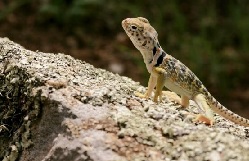Chihuahuan Collared Lizard (Crotaphytus collaris fuscus)
Description: Length: 8 to 14 inches including tail. Colors and markings are diverse in Crotaphytus collaris. They are sexually dimorphic. Males tend to be green to tan colored with patterns of dorsal spots and bars to a speckled pattern across the dorsum. Male C. collaris can also exhibit vivid yellow and orange head coloration. Female C. collaris tend to be less colorful except during breeding season when they exhibit bright orange side spots or bars. Both male and female C. collaris possess two prominent collar-like black bands at their neck, hence their name.
Habitat: C. collaris inhabit rocky areas with sparse vegetation. Boulder strewn hillsides and rocky outcroppings are common in their living areas. Collared lizards dig under boulders to sleep and lay their eggs
Range: Southern New Mexico
Found in these States:
NM
Diet: Crotaphytus collaris is mainly insectivorous and carnivorous. Occasionally their diet may consist of plant matter. C. collaris does vary its diet depending on what is abundant. Food can range from grasshoppers to smaller lizards
Reproduction: Crotaphytus collaris courts and mates on the ground in spring to early summer. An average clutch size is 4 to 6 eggs and 1 to 2 clutches are produced per year. Eggs are deposited in underground burrows underneath rocks or loose sand. The incubation period for the eggs is generally 53 to 94 days. Adult C. collaris exhibit no parental care.
Status: Crotaphytus collaris is assessed as Least Concern because this species is widely distributed and is represented by many stable populations. It faces no major threats at present.
»» Kingdom: Animalia - Animals
»» Phylum: Chordata - Chordates
»» Subphylum: Vertebrata - Vertebrates
»» Class: Reptilia - Reptiles
»» Order: Squamata - Lizards
»» Family: Crotaphytidae - Collarded & Leopard Lizards
»» Genus: Crotaphytus
»» Species: Crotaphytus collaris - Common Collarded Lizard
»» Subspecies: Crotaphytus collaris fuscus - Chihuahuan Collared Lizard
This article uses material from the Wikipedia article "ANIMAL", which is released under the Creative Commons Attribution-Share-Alike License 3.0. Content may have been omitted from the original, but no content has been changed or extended.
|













